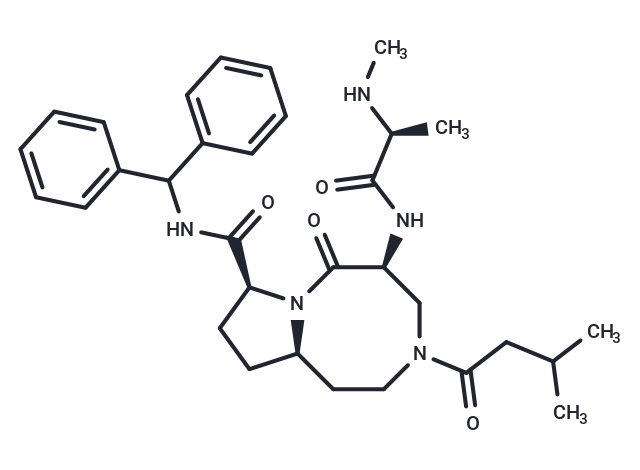购物车
- 全部删除
 您的购物车当前为空
您的购物车当前为空

Xevinapant (Debio-1143) 是一种有效的 Smac 模拟物和 IAP 的拮抗剂,能够抑制 XIAP,cIAP1 和 cIAP2 蛋白,Ki 值分别为 66.4,1.9 和 5.1 nM。

Xevinapant (Debio-1143) 是一种有效的 Smac 模拟物和 IAP 的拮抗剂,能够抑制 XIAP,cIAP1 和 cIAP2 蛋白,Ki 值分别为 66.4,1.9 和 5.1 nM。
| 规格 | 价格 | 库存 | 数量 |
|---|---|---|---|
| 1 mg | ¥ 375 | 现货 | |
| 2 mg | ¥ 523 | 现货 | |
| 5 mg | ¥ 828 | 现货 | |
| 10 mg | ¥ 1,320 | 现货 | |
| 25 mg | ¥ 2,890 | 现货 | |
| 50 mg | ¥ 4,370 | 现货 | |
| 100 mg | ¥ 6,230 | 现货 | |
| 200 mg | ¥ 8,560 | 现货 | |
| 500 mg | ¥ 12,700 | 现货 | |
| 1 mL x 10 mM (in DMSO) | ¥ 1,330 | 现货 |
| 产品描述 | Xevinapant (Debio-1143) is a potent Smac mimetic and an antagonist of IAP (inhibitor of apoptosis protein via E3 ubiquitin ligase), binding to XIAP-BIR3, cIAP1-BIR3 and cIAP2-BIR3 with Ki of 66.4 nM, 1.9 nM, and 5.1 nM, 50- to 100-fold higher affinities than the Smac AVPI peptide. Phase 1. |
| 靶点活性 | CIAP2-BIR3:5.1 nM(Ki), XIAP BIR3:66.4 nM(Ki), CIAP1-BIR3:1.9 nM(Ki) |
| 体外活性 | Xevinapant是一种Smac模拟物,能够在氢键和疏水作用上密切模仿AVPI肽与XIAP的结合,并与XIAP的W323有额外的疏水接触。相比Smac AVPI肽,Xevinapant对这些IAPs的敏感性更高,绑定亲和力提高了50-100倍。当浓度为1μM时,Xevinapant能完全恢复由500nM XIAP BIR3在无细胞系统中抑制的caspase-9活性。在MDA-MB-231细胞中,Xevinapant快速诱导cIAP1降解,并且能够拉下XIAP蛋白。Xevinapant对多种人类癌细胞系具有有效的抑制作用,在MDA-MB-231细胞和SK-OV-3卵巢细胞中表现出144和142nM的IC50,对正常类人乳腺上皮MCF-12F细胞和初级人正常前列腺上皮细胞具有低毒性。Xevinapant通过诱导caspase-3激活和PARP切割,在MDA-MB-231细胞中诱导凋亡。[1] |
| 体内活性 | Xevinapant在小鼠、大鼠、非人类灵长类动物和狗中具有良好的药代动力学(PK)特性和口服生物利用度。在MDA-MB-231异种移植模型中,Xevinapant有效促进cIAP1降解和procaspase-8的处理,以及在100 mg/kg剂量下肿瘤组织中PARP的裂解,并且即使在200 mg/kg的剂量下也表现出良好的耐受性。Xevinapant在100 mg/kg剂量下显著抑制肿瘤生长,p值为0.0012。[1] |
| 激酶实验 | Fluorescence Polarization Based Assays for XIAP, cIAP1, and cIAP2 BIR3 Proteins: FL-AT-406 (the fluorescently tagged AT-406) is employed to develop a set of new FP assays for determination of the binding affinities of Smac mimetics to XIAP, cIAP-1, and cIAP-2 BIR3 proteins. The Kd value of FL-AT-406 to each IAP protein is determined by titration experiments using a fixed concentration of FL-AT-406 and different concentrations of the protein up to full saturation. Fluorescence polarization values are measured using an Infinite M-1000 plate reader in Microfluor 2 96-well, black, round-bottom plates. To each well, FL-AT-406 (2, 1, and 1 nM for experiments with XIAP BIR3, cIAP-1 BIR3, and cIAP-2 BIR3, respectively) and different concentrations of the protein are added to a final volume of 125 μL in the assay buffer (100 mM potassium phosphate, pH 7.5, 100 μg/mL bovine γ-globulin, 0.02% sodium azide, with 4% DMSO). Plates are mixed and incubated at room temperature for 2-3 hours with gentle shaking. The polarization values in millipolarization units (mP) are measured at an excitation wavelength of 485 nm and an emission wavelength of 530 nm. Equilibrium dissociation constants (Kd) are then calculated by fitting the sigmoidal dose-dependent FP increases as a function of protein concentrations using Graphpad Prism 5.0 software. In competitive binding experiments for XIAP3 BIR3, AT-406 is incubated with 20 nM XIAP BIR3 protein and 2 nM FL-AT-406 in the assay buffer (100 mM potassium phosphate, pH 7.5; 100 μg/mL bovine γ-globulin; 0.02% sodium azide). In competitive binding experiments for cIAP1 BIR3 protein, 3 nM protein and 1 nM FL-AT-406 are used. In competitive binding experiments for cIAP2 BIR3, 5 nM protein and 1 nM FL-AT-406 are used. For each competitive binding experiment, polarization values are measured after 2-3 hours of incubation using an Infinite M-1000 plate reader.The IC50 value, the inhibitor concentration at which 50% of the bound tracer is displaced, is determined from the plot using nonlinear least-squares analysis. Curve fitting is performed using the PRISM software. A Ki value for AT-406 is calculated. |
| 细胞实验 | Cells are seeded in 96-well flat bottom cell culture plates at a density of (3-4) × 103 cells/well with AT-406 and incubated for 4 days. The rate of cell growth inhibition after treatment with different concentrations of AT-406 is determined by assaying with (2-(2-methoxy-4-nitrophenyl)-3-(4-nitrophenyl)-5-(2,4-disulfophenyl)-2H-tetrazolium monosodium salt (WST-8). WST-8 is added to each well to a final concentration of 10%, and then the plates are incubated at 37 °C for 2−3 hours. The absorbance of the samples is measured at 450 nm using a TECAN ULTRA reader. Concentration of AT-406 that inhibited cell growth by 50% (IC50) is calculated by comparing absorbance in the untreated cells and the cells treated with AT-406. (Only for Reference) |
| 别名 | SM-406, Debio-1143, AT406, ARRY-334543 |
| 分子量 | 561.71 |
| 分子式 | C32H43N5O4 |
| CAS No. | 1071992-99-8 |
| Smiles | CN[C@@H](C)C(=O)N[C@H]1CN(CC[C@H]2CC[C@H](N2C1=O)C(=O)NC(c1ccccc1)c1ccccc1)C(=O)CC(C)C |
| 密度 | 1.21 g/cm3 |
| 存储 | Powder: -20°C for 3 years | In solvent: -80°C for 1 year | Shipping with blue ice. | ||||||||||||||||||||||||||||||||||||||||
| 溶解度信息 | H2O: < 1 mg/mL (insoluble or slightly soluble) DMSO: 20 mg/mL (35.61 mM) Ethanol: 93 mg/mL (165.6 mM) | ||||||||||||||||||||||||||||||||||||||||
溶液配制表 | |||||||||||||||||||||||||||||||||||||||||
DMSO/Ethanol
Ethanol
| |||||||||||||||||||||||||||||||||||||||||
评论内容